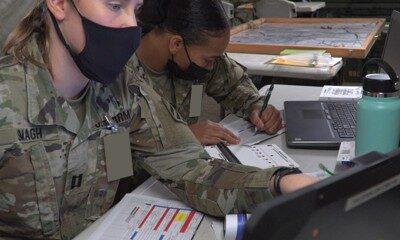The Army is in the midst of a significant shift in how it buys, builds and delivers technological capabilities to warfighters. At the crux of those plans is a cloud infrastructure called cArmy that can deliver communications, tools and sensor data so commanders can have a clear digital picture of the battlespace and make crucial decisions more quickly.
The Army created its Enterprise Cloud Management Office in 2019 to mold those plans. That office was elevated to an agency last year and is now focusing on modernizing business systems and implementing enterprise solutions, such as migrating from the Defense Department's temporary telework-friendly Microsoft Teams environment to the more permanent Army 365 solution.
2020 was about laying the foundation for cArmy, 2021 was about migrating business systems and tweaking the processes that come with them, and now 2022 is about going global and expanding the Army's cloud offerings.
Paul Puckett, director of the Enterprise Cloud Management Agency, told FCW that priorities this year focus on determining "the opportunity truly in the tactical domain to leverage cloud computing and then start to deliver really persistent mission command as a service for the Army…. That mission is going to drive us to invest heavily in understanding and then leveraging" cloud computing capabilities outside the continental U.S. while tying the enterprise and tactical domains together under a unified network.
Creating a global digital infrastructure
ECMA's efforts also build on the Army's digital transformation plan, which outlines how the service will use technology to change the way it conducts business operations and warfighting. As a result, Puckett said, "cloud really then becomes the global digital infrastructure that that mission is essentially executed on."
Army CIO Raj Iyer has promised shifts in IT policy, chiefly through the recently released Digital Transformation Strategy and the subcomponent Unified Network Plan. Cloud infrastructure is a major element of several other recent DOD strategies related to data, software modernization and the vision for Joint All-Domain Command and Control for which the Army shares some responsibility.
Puckett said all those strategies intersect, and ECMA's job is to ensure that they are coherent and usable across the Army. "We're typically talking about the way we want to fight, the way we want to work, where and how our data and our software [are] just available when we need [them]," he added. "And that's so much from the operational perspective. But then we have to understand that someone is designing digital infrastructure that actually enables that outcome. In that intersection between the two is where we've gone awry in the past decades."
Part of ECMA's mission is to design and deploy that digital infrastructure and determine the computing and storage footprint and the common services that will come with it, while also understanding its limitations and opportunities.
"One of the critical components of cloud infrastructure is broad network access," Puckett said. "We're naturally constrained when it comes to our ability to leverage [geosynchronous Earth orbit]. And how can we start to tap into [low Earth orbit] and [medium Earth orbit]? Where are those ground stations going to be? What is their connectivity…? Where's the first hop when it comes to computing resources that are going to enable that persistent mission command?"
Those questions become increasingly important as the Army experiments with tactical cloud outside the continental U.S. because preserving data sovereignty involves bringing the necessary computing and storage to the network's edge. Partnerships and experimentation are crucial to success.
"Everyone acknowledges that the role they have to play is immediate feedback for immediate experimentation," Puckett said. "And then how do we take that experimentation and, if it's successful, turn it into the new way that the Army does business? We've already demonstrated the value of persistent mission command as a service specific to this effort" through the Cobra Gold multinational military exercise and ongoing capabilities in contested environments.

In the future, mission command as a service could have an impact on how the Army trains and structures its forces, he added.
Experimenting with cloud in theater
Those efforts are part of a broader strategy for cloud-enabled mission command. As part of that, the Army has been testing its Command Post Computing Environment (CPCE), which provides a common operating picture so that commanders or their staffs can "look at one screen and be able to see all of the operational data that is important for his or her mission," said Col. Matthew Paul, project manager for mission command at the Army's Program Executive Office for Command, Control and Communications-Tactical. "So everybody has the same sight picture of where their friendly forces are, where the enemy forces are, what do we need to do for our mission, where are the [operational] risks."
CPCE is not cloud-contingent, but certain units that are experimenting with it — including the 82nd Airborne Division, 101st Airborne Division and 18th Airborne Corps — have volunteered to try the cloud-capable option with help from ECMA. After Cobra Gold, the 18th Airborne Corps' Project Ridgway will continue testing mission command as a service.
Mission command cloud services are also being utilized by I Corps, III Corps, V Corps, U.S. Army Pacific, and U.S. Army Europe and Africa's G-3 Mission Command Support Division at maturity levels, Puckett said. The goal is to create greater structure and repeatability while enhancing training, operational readiness, and tactics, techniques and procedures.
Paul said officials plan to align CPCE with the Army's data strategy, which is heavily reliant on the ability to house data and applications in a cloud environment. "That simplifies how we exchange data between different echelons, and it provides a capability for the tactical formations that they don't have today — a capability that's persistent, that they can reach wherever they [are] in the battlefield," he added, noting that field testing began as soon as applications could be moved to the cloud environment.
Although continued experimentation this year seeks to answer technical questions, officials also want to address challenges related to doctrine and how the units use the capability. "There are certainly technical challenges to overcome, which we will," Paul said. "But we're experimenting so we're still trying to figure out what the unknown unknowns are as we leap into the cloud."
Many of the technical challenges are security related and include ensuring that performance and security coalesce and finding the right mix of cloud and on-premises services.
"I think we're trying to find that right sweet spot," Paul said. "Commercial cloud offers a lot of great things. And we want to try to find how using commercial cloud [is] congruent with our current posture for how we configure networks and how we assign certain roles and access for things like data. We've got to harmonize that. That's not an easy problem to solve, but it is solvable. And some of that is technical, but some of it is policy-related as well."
The other challenge is updating systems at the speed of feedback, Paul said. "We get a lot of feedback in the field, and being able to roll that feedback into our software development process or DevOps pipeline quicker so they can get the capability they need quicker is a challenge," he added. "So that's something we're certainly trying to align to."
Making a foundational change
Lt. Col. Phil Smith, data systems development officer for the Army's Network Cross-Functional Team, said it's important to note that the Army isn't completely moving to tactical cloud, and the trick has been harmonizing cloud and non-cloud infrastructure.
"We're not advocating a wholesale move to cloud with capabilities and not having anything at the physical location with the units," added Smith, who has been instrumental in bridging cloud technology for CPCE testing. "So I think paramount to understanding across the Army when we talk about these things is they have to work in concert with the soldier on the edge. That is, to be honest with you, part of the bigger technical challenges that we're having."
There is still testing to be done, but the potential payoff is worth the effort. "It takes a little vision to be able to [say]: 'Hey, this new capability, here's what we could do with this in the future,'" Smith said. "It's a foundational change we're trying to make that…if it's successful and if it becomes a thing, it's going to have lasting effects in a beneficial way down the road."
The second phase of CPCE will build on the experimentation and be incorporated into future capability sets being developed by the Army's Network Cross Functional Team for 2023.




